To visit Versailles, one of history’s most opulent and magnificent royal palaces, simply has to be on the to-do list of any serious visitor to France.
The French monarch Louis XIV, the ‘Sun King’, built Versailles to reflect his absolute power, to awe his opponents and glorify his achievements. It became his playground but also a symbol of the decadence swept away by the French Revolution. A UNESCO World Heritage Site since 1979, its spectacular gardens, lavish rooms and decoration make it one of the crown jewels of France, if not the world.
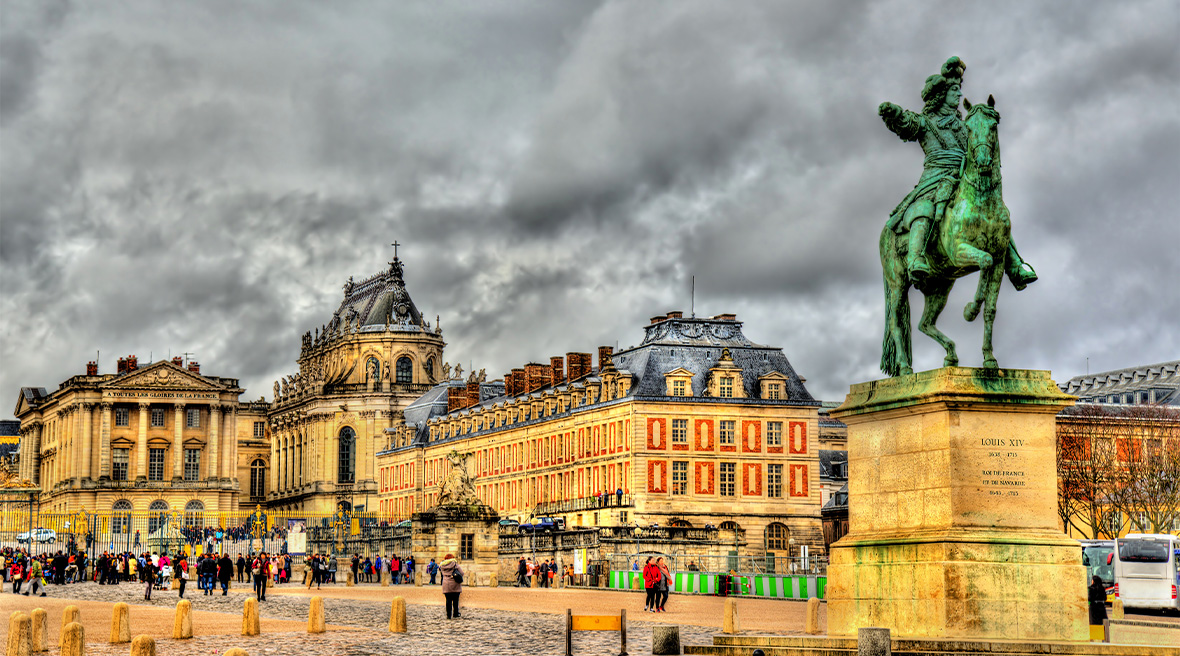
Statue of Louis XIV, the Palace of Versailles
Where is Versailles?
The palace of Versailles is on the south-western outskirts of Paris, in the Yvelines department of Île-de-France. The centre of Paris is around 12 miles away.
Driving to Versailles from Calais
The quickest route to Versailles from our terminal at Calais is via the A16. This road has tolls and should take around three and a half hours.
The Palace of Versailles
The sheer scale and splendour of Versailles is almost overwhelming. 2,300 rooms over 63,154 m2, 2,000 acres of gardens and parkland, 60,000 artworks. Versailles has its own opera house, congress hall and a royal chapel that is bigger than some cathedrals. At its height as the centre of government and court life it was the workplace of 10,000 people, and cost a quarter of the national budget of France to maintain.
History of the palace
The estate we see today developed over time. Louis XIII first built a hunting lodge on the site in 1623, and then later a small château. His son Louis XIV began its transformation in 1661, and as the ‘Sun King’ grew more ambitious Versailles continued to expand for the rest of his epic 72-year reign. Louis worked with different architects to realise his vision, and when he moved his government and court here in 1682, it became a mini-city entirely focused on the daily life of the King.
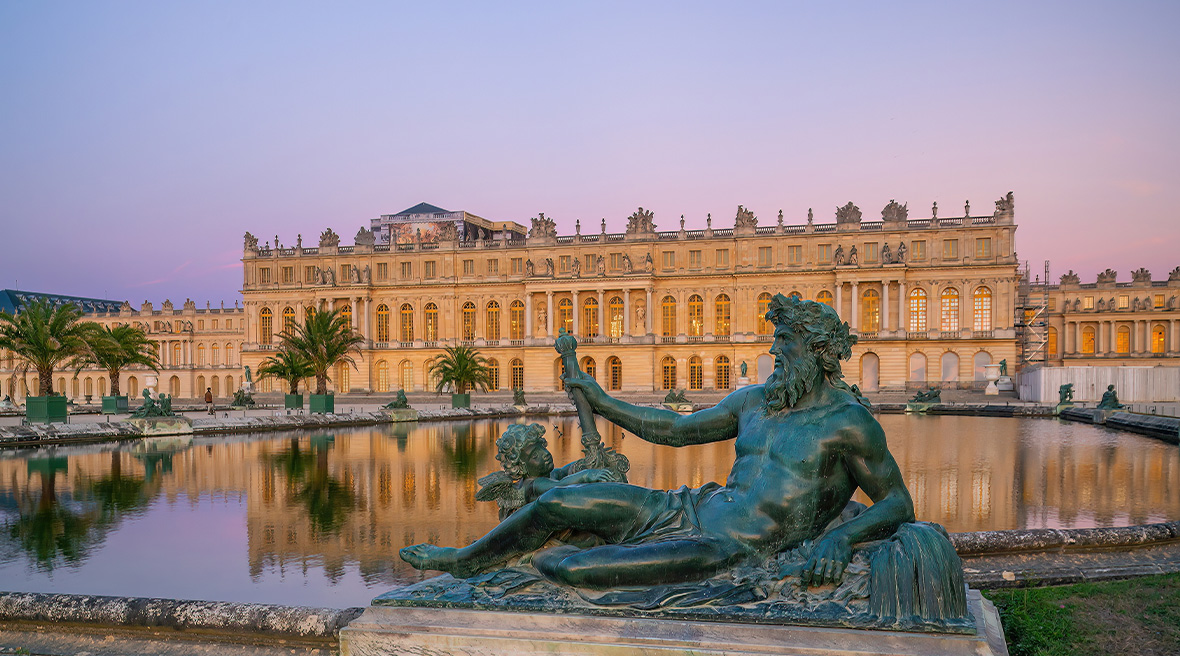
Statue of Neptune, Versailles
Notable additions to the palace and estate were made in the 18th century. The palace was abandoned during the Revolution but used as a residence by Napoleon Bonaparte. When the monarchy was restored, so was Versailles, and under King Louis-Phillipe it became a museum of French history. Rooms like the Gallery of Great Battles date from this period.
Versailles first opened to the public as a museum in 1883. The Treaty of Versailles, formally ending the First World War, was signed at the palace in 1919. For much of the 20th century the palace underwent major restoration, and this work to an extent never stops. The gardens, for example, have to be completely replanted every 100 years. In 2024 Versailles will host the equestrian events at the Paris Olympics.
Visiting the palace
With 15 million visitors every year, Versailles is one of France’s most popular tourist attractions. To visit Versailles you must book a time slot when you purchase your Versailles tickets and enter within half an hour of the time printed on your ticket.
The palace, gardens, Estate of Trianon and park is open every day except Mondays throughout the year, with longer opening times during high season.
Leave plenty of time to see all you want at Versailles. You could easily spend a day here, if you want to fully explore the whole estate. There are a range of tickets for specific parts of the estate.
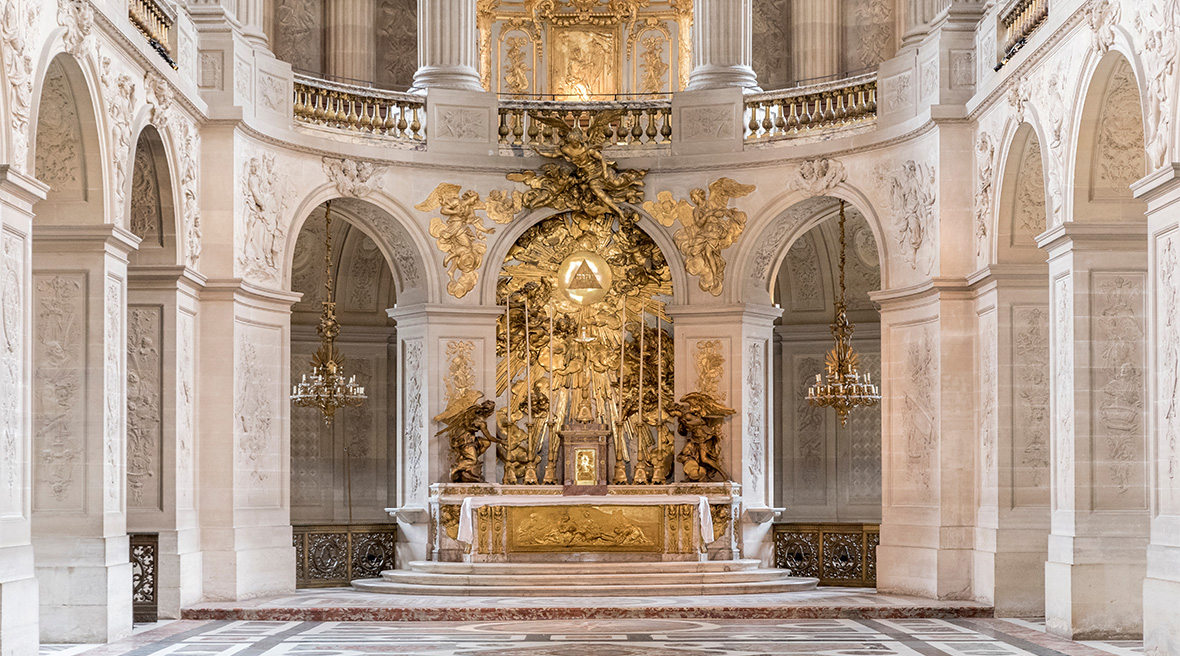
The altar of the Royal Chapel, Versailles
The Hall of Mirrors
The 73 metre long gallery with 357 mirrors is the most famous of all the rooms of Versailles. It replaced the terrace that had previously separated the private apartments of the King and Queen. At the time of its construction in 1681 mirror-making was a secretive trade, and when Louis managed to smuggle some of Venice’s finest craftsmen to Versailles, it incurred a death sentence from the Venetian guild of mirror makers!
The Hall of Mirrors is a room full of lavish decoration, its marble walls lined with gilded statues, glass chandeliers hanging from the magnificent ceiling paintings of Charles Le Brun. History has been made in this room. Louis XIV processed here every day with his courtiers, lavish receptions were staged where the King would hold court, and it was the room where the Treaty of Versailles was signed.
The estate of Trianon
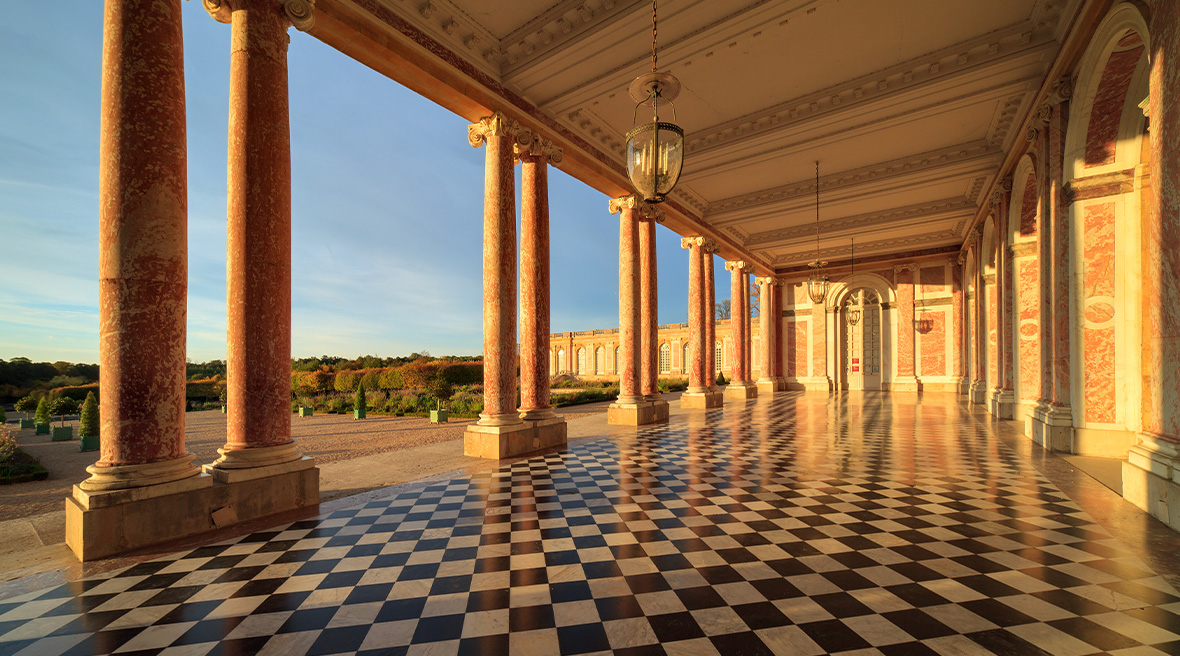
The Grand Trianon, ‘a little palace of pink marble’
The royal estate of Trianon was conceived by Louis XIV as a refuge from the circus that attended his every move at the palace (a circus, it has to be said, that he encouraged at every turn). The estate comprises the Grand Trianon, a complex of elegant marble buildings and landscaped gardens; the Petit Trianon, a neo-classical intimate palace, and the Queen’s Hamlet, Marie Antoinette’s vision of a rural village, set around a lake with a working windmill.
The estate of Trianon is open to the public and tickets can be bought separately from those to the palace and gardens, or included in the general Versailles ticket.
The gardens at Versailles
The fabled gardens are just as breathtaking as the palace, if not more so. They took 40 years to create, featuring a mix of formal and landscaped gardens, bodies of water, fountains, groves and walks. Seen from the Hall of Mirrors, the ‘Grande Perspective’ runs all the way down the Royal Way and the mile-long Grand Canal to the Fountain of Apollo.
The parterre of the Orangery, situated next to the palace, is one of the most famous and beautiful in the world, with its distinctively patterned lawns. Some of the orange, lemon, palm and pomegranate trees displayed here in the summer months are more than 200 years old.
Entry to the gardens is free, with the exception of the Musical Gardens or Musical Fountains Shows that are held from time to time during the high season.
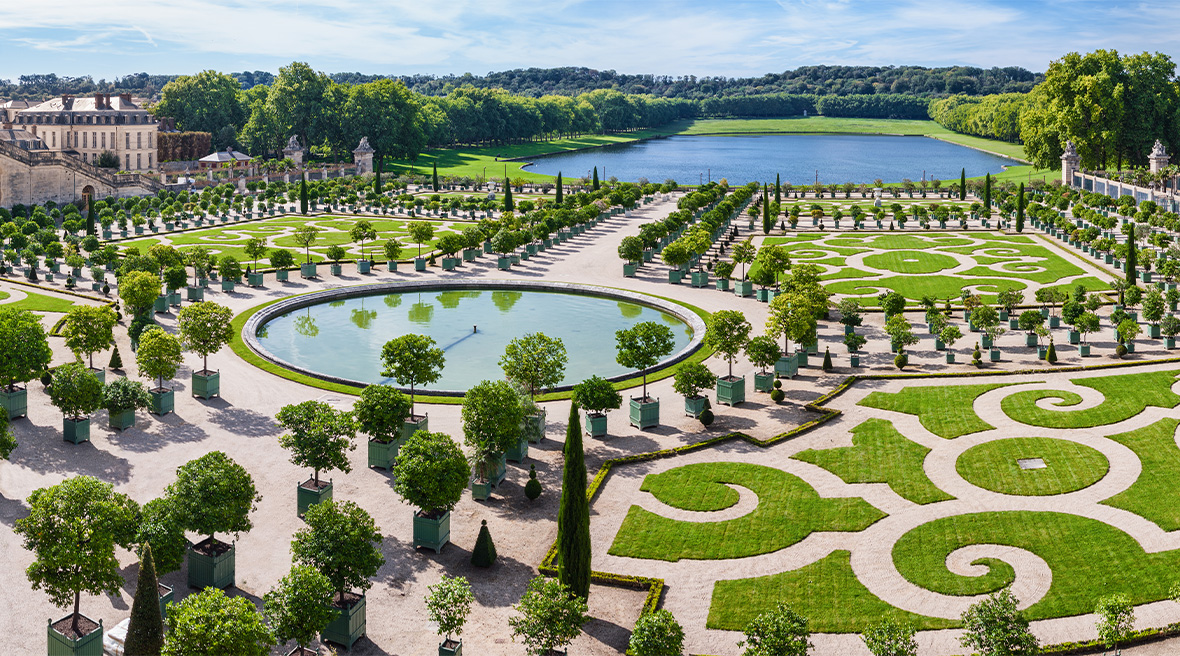
The Orangery gardens, Versailles
Discover the park at Versailles
The park was laid out by Louis XIV’s garden designer André Le Nôtre between 1668 and 1679 and stretches as far as the eye can see either side of the Grand Canal. The King used it for huge parties, to sail gondolas and to skate in the winter. Go for a wander (entry to the park is free) and you will stumble upon statues, fountains, ponds and copses amongst the trees and hedges. Make sure you get a picture beside the monumental statues of Neptune and Apollo!
Things to do in Versailles after visiting the palace
Visit the Gallery of Coaches
A short walk from the palace is the Royal Stables, and on the ground floor you will find the Gallery of Coaches, Europe’s largest collection of royal carriages dating back to the 17th century. The collection includes travelling thrones used for ceremonial occasions by a range of French monarchs, including Louis XIV, Napoleon and Charles X. The Gallery of Coaches is open on Saturday and Sunday afternoons and entry is free.
Versailles Royal Opera House
Not every palace has its own opera house – but Versailles is not like any other palace. The Royal Opera House is in the North Wing, and was opened in 1770. Spectacular in its design and decoration, it could be used as a ballroom and banqueting hall, and was restored after the Second World War to its former glory. It stages a full programme of operas and concerts, and the opera house is included in the guided tours of Versailles.
A leisurely stroll in The King’s Garden (Le Potager Du Roi)
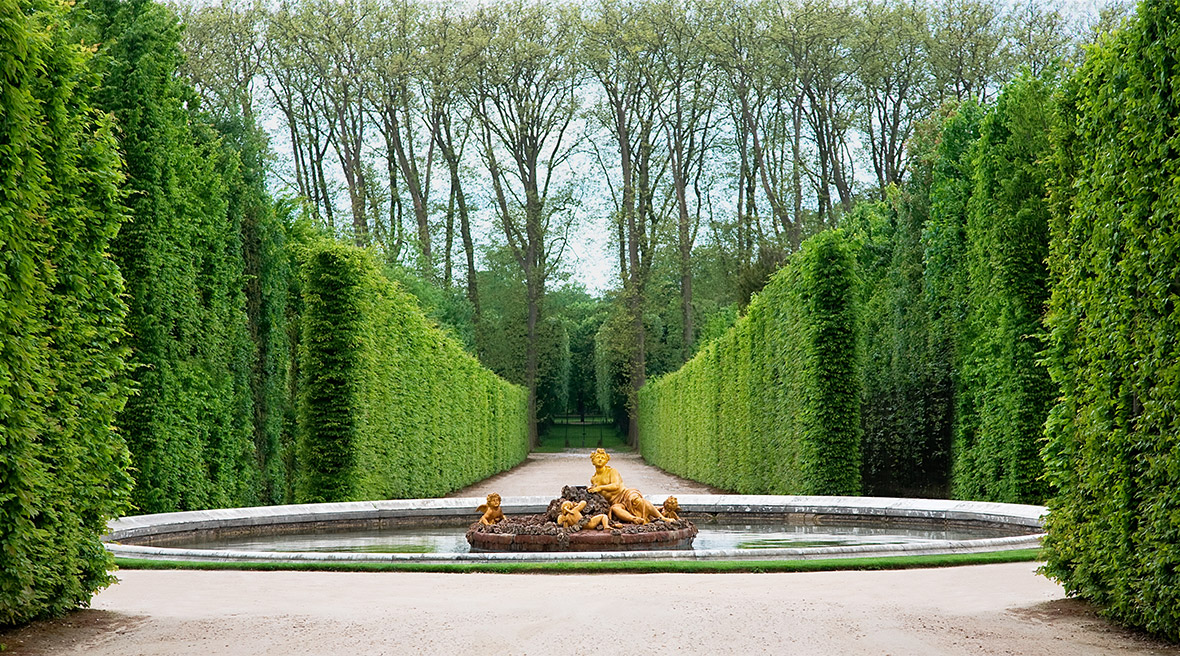
The gardens of Versailles contain many hidden fountains and groves
The King’s Garden is a small oval shaped enclave of trees and green space beyond the main ornamental gardens of Versailles. It is an English style garden with a central pillar, mirror fountain and pool and a colourful array of borders laid out for Louis XVIII in 1817. Like much of the gardens at Versailles, the King’s Garden was badly damaged in a storm in 1999. It makes for a pleasant stroll whatever the season.
Notre-dame de Versailles
Although it lies in the streets outside the palace, the hand of the ‘Sun King’ is still heavy on the baroque Church of our Lady. Louis XIV offered it as a gift to the town of Versailles and laid its cornerstone in 1684. As the parish church of Versailles, it faithfully recorded the baptisms, weddings and deaths of the French royal family over several centuries.
Explore Versailles with Eurotunnel Le Shuttle
The palace and gardens of Versailles are one of the world’s great treasures, and anyone with an interest in history and culture would be enriched by a visit. Let Eurotunnel Le Shuttle be your carriage across the Channel in only 35 minutes.